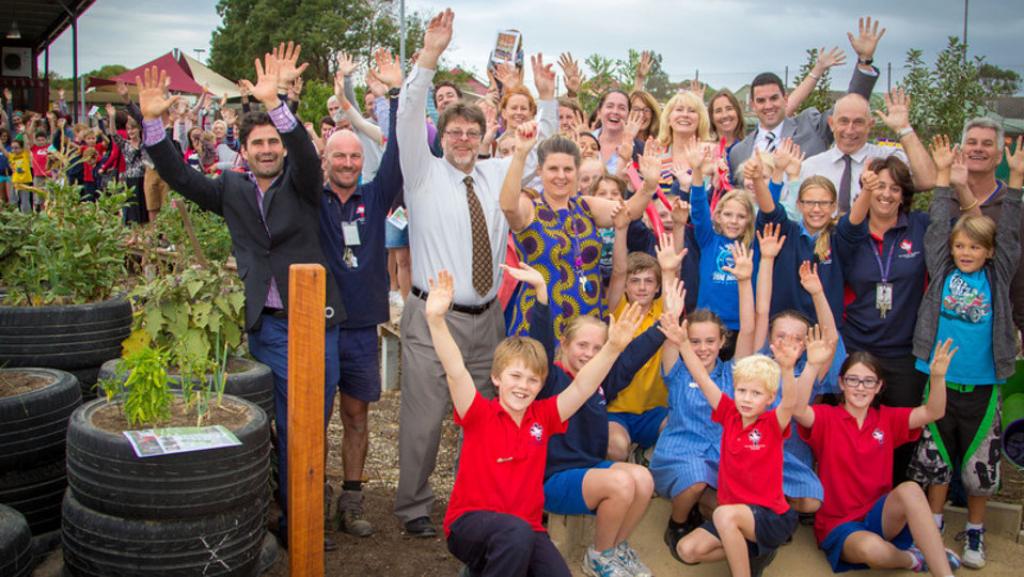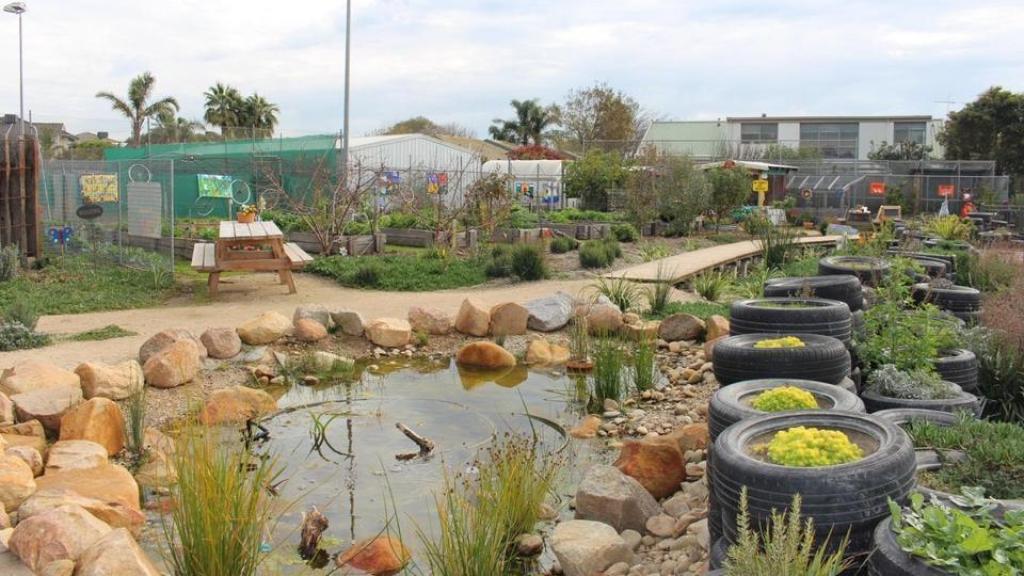Bringing a vision to life
Whole school case study: St Louis de Montfort’s Primary School
School description: St Louis de Montfort’s Primary School is a large catholic primary school in the Melbourne bayside suburb of Aspendale on the Mornington Peninsula. The school is located on 3.5 hectares of reclaimed swampland between the wetlands and the bay, and it comprises 760 students, 28 classes and 85 staff.
At St Louis we are passionate about the land on which we live and making our environment sustainable – the school’s mantra is ‘making sustainable students into sustainable citizens now and for the future’.
We believe in empowering our students and community through sustainable education across all areas of the curriculum and providing a ‘learnscape’ where our community can get back to nature and get their hands dirty.
Teacher: Julie Wynne
Outcomes
- Developed a ten-year sustainability plan
- Completed and funded stage one of the learnscape
- Linked curriculum to sustainable education
- Established Garden 2 Kitchen (G2K) program
- Empowered students, teachers, the school and the wider community through hands-on education and leadership.
As a school community we have developed a plan for the future, which includes:
- Development of a vision for a ten-year Sustainable School Education Precinct. We started by seeking input from our students and the school community. With this information we developed the design with RB Landscapes. Once the design was endorsed we ran information sessions for students, parents and the school board to detail the designs and plans.
- Seeking funds from a range of sources to pay for the infrastructure and the program. St Louis Parents and Friends were very supportive. We developed a partnership with the Bendigo Bank and endeavoured to gain funds from groups such as Rotary and RSL. This was not very successful and in the end the school funded the project.
- The plans were displayed at the school and, once the learnscape commenced, we gained the community support.
- Development of a Garden to Kitchen (G2K) program that would cater for large numbers of students actively engaging in the garden as part of the curriculum. This program is supported by parents who pay a levy for students to participate each term. G2K is celebrated at the end of every term with a parent afternoon, which parents, grandparents and community members attend – the children show them around the garden and taste the delights from the kitchen.
- Attainment of ResourceSmart Schools (Victoria) five-star certification.
- Expanding student leadership.
- Linking student wellbeing to sustainable initiatives.
- Developing strategies to get the whole school community on board with sustainability.
- Becoming an exemplary sustainable school.
Resource savings and environmental improvement
As part of attaining ResourceSmart Schools five-star certification we have been able to:
- monitor our use of resources
- develop and implement management plans to reduce our water and energy usage
- decrease our waste
- increase the biodiversity of the site.
To make sustainability a normal part of everything we do, we needed a baseline audit to review all our practices and procedures. A key example of this was our review of the school's waste procedures. We have declared ourselves a national forest, with a take-in take-out rubbish policy. We have changed our bin systems and photocopy procedures.
We have significantly reduced the waste going to landfill, saving $1.76 per student between 2014 and 2015. We have also saved 86 cents per student on paper usage. This is a whole-school approach.
We have completed the first stage of our sustainability learnscape.
The school environment now includes many amazing features, such as vegetable gardens, an orchard, a chicken coop, observation ponds, grey-water recycling, boardwalks, meandering paths, recycled tyre and sleeper walls, a recycled-tyre amphitheatre, a bush tucker garden, an aquaponics garden, a permaculture area, a rabbit hutch, a bird aviary, stone paths, a sheoak woodland area, swales, and wood-fired pizza oven and kitchen built from reused shipping containers. The first stage of this plan was been funded by the school and community and was completed between 2008-2014.
Participation by student, school and communities
Our project involves the whole school community. Students participate in programs such as the G2K; teachers run music, art, cooking and science classes in the spaces and adjacent wetlands, surrounded by animal and plant life.
The school – and its community of parents, friends and local residents – participate in on-site workshops, markets and celebrations that focus on making our environment more sustainable.
We also believe that, as an exemplary sustainable school, we have a moral obligation to support other schools and communities on their journeys. Therefore we have an open-door policy where we provide tours and support for our local and wider community. We also present at events such as local council network meetings, Kids Teaching Kids programs and ResourceSmart awards.
Student learning and engagement
The opportunities for engagement and learning available for students involved in St Louis’ sustainability initiatives are amazing: consider, for example, the G2K program cooking, animal husbandry work, gardening, propagating and ponding. The student leaders who run workshops for students, parents, teachers, members of the wider community and prospective parents are enthusiastic and their knowledge of different aspects of sustainability is clearly evident in the feedback we receive from participants.
Unexpected and wonderful outcomes
The program has had a much broader impact than anticipated. Walking around the school there are many examples of an integrated approach to sustainability:
- seedlings outside classroom doors – some in boxes, others facing the light – showing chemical science experiments in action
- hot house constructions displayed as part of the ICT curriculum
- art work around the precinct
- drumming classes in the amphitheatre
- students playing in the ponds and getting back to nature.
A particularly moving outcome has been the spaces created as sanctuaries for special needs students and a memorial garden for students who have lost parents.The pride taken in our sustainability spaces and initiatives by the whole school and wider community has been surprising. I regularly hear from parents that one of the reasons they chose St Louis was because of our passion for sustainability. Recognition by the wider community through awards has also been rewarding and humbling.
Reflections
There are a number of elements that need to be aligned to achieve success.
- Supportive leadership – I am fortunate that our principal is a forward-thinker who is passionate about sustainability. We have a ten-year plan, and a staff member is released two days a week to support sustainability initiatives across the school and funds are prioritised to support activity.
- The teacher environmental group – this group has helped to share the load and to ensure that I am not the lone crusader.
- A strong student leadership program – this ensures we foster environment and sustainability school leaders.
- Getting the school and community on board early on the journey. We did this by running celebration days, workshops and informing the community of our plans for the spaces. Community garden groups and our Parents and Friends groups have also been very supportive.
- Support, involvement and partnerships with the wider community – for example, Kingston Council, Dolphin Research Institute, AuSSI, Catholic Diocese, CERES. Mentor schools and teachers such as Bill Thomas Bentleigh Secondary School.
- Involvement in a structured sustainability journey through the Resource Smart Schools framework (AuSSI) – this program has provided us with the scaffolding to start our journey.
- Pope Francis’s Encyclical ‘Laudato Si' on Care for Our Common Home – released on 19th July, 2015 – where he calls for global action on sustainability. This is a fantastic impetus for our school community to take action to care for our common environment.
Networks
Forging links with secondary schools and supporting the Grade 6 Sustainable Warrior students is a challenge. It is really frustrating when our students return to tell us that their secondary schools are doing nothing for sustainability. Regional sustainability networks help us take it further and support our students. Keep inspiration alive in your school by empowering a range of members of the school community to contribute to sustainability projects. Surround yourself with buddies to help you hold the vision. We have appreciated Karen Jones, former Kingston Council Education Officer, and Bill Thomas from Bentleigh Secondary College, who have been not only inspirational, but real mentors on our journey.
Resources
Resource Smart Schools Victoria http://www.sustainability.vic.gov.au/services-and-advice/schools
Cool Australia http://www.coolaustralia.org
Ceres Environmental Park http://sustainability.ceres.org.au
Australian curriculum and/or state frameworks
AusVels http://ausvels.vcaa.vic.edu.au/CrossCurriculumPriorities
Catholic Education Sustainability Framework

